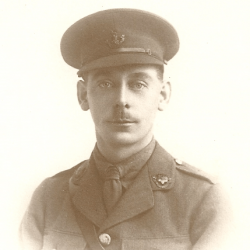Harold Ingham was born in Moston, Manchester on March 19, 1886. His father, William Walter Ingham was a cotton yarn agent. Harold was educated at private school in St. Annes on Sea which he attended with his older brother Claude Harrop Ingham. By 1911 Harold was living at “Vine House” in Moston with his parents, his brother Claude and his younger sister Irene. The family employed two servants. Harold and Claude worked in their father’s business as cotton yarn agents.
On September 9, 1914, Harold joined the 6th Reserve Battalion Manchester Regiment as a private (#2746) and was subsequently promoted to Corporal. On March 11, 1915 he was commissioned as a Second Lieutenant into the 9th Battalion Manchester Regiment and joined the 2/9th in training at Southport. 2/Lt. Harold Ingham was one of the 5 Officers (and 222 men) who traveled to Gallipoli in July 1915, joining the Battalion at Cape Helles on July 23rd.
There is no mention of him in the Battalion war diary but there is anecdotal evidence from the Ashton Reporter Newspaper, (and confirmed by his service record), that he transferred to C Company in late August and took over command of the Company on September 17th when temp. Captain George William Handforth was admitted to hospital in Imbros and subsequently medically evacuated to Malta. The London Gazette notes that he was made a temporary Captain on September 20, 1915 while he was in charge of a company. However, he too succumbed to the endemic sickness at Cape Helles and on December 24, 1915 was sent sick to hospital reporting that for the previous 4 days had suffered from profuse diarrhea, passing blood and mucus up to 30 times a day. He remained in hospital at Mudros and after he sufficiently recovered arrived at Malta on the hospital ship Letitia on January 15, 1916. Here he was admitted to St. Andrews Hospital and diagnosed with dysentery remaining there until January 24 when he resumed his journey to England, again on the Letitia. He arrived in England on February 1, 1916 and was admitted to the 3rd London General Hospital, Wandsworth.
It was a slow and difficult road to full recovery, only being passed fit for home service (except for route marches) in July and reporting to camp at Witley. He was passed fit for General Service on October 16, 1916. Once recovered, he was attached to the 21st Battalion, Manchester Regiment, posted to France and was subsequently promoted to Lieutenant on July 1, 1917.
On October 26, 1918 at Le Cateau, he suffered shrapnel wounds to the left side of his neck and left leg. The shrapnel produced a small wound just above the clavicle and on his left tibia. He was X-Rayed at the CCS without issue and quickly removed to the 1st British General Hospital. From there he was evacuated back to England arriving at Southampton on November 3, 1918 where he was admitted to the 3rd London General Hospital, Wandsworth where he had been in 1916. The wounds were not life threatening and he recovered over the next few months, mainly regaining strength of the middle left trapezius muscle in his upper back which had atrophied as a consequence of the neck wound.
On December 18, 1918 he was sufficiently fit to marry Marjorie Howorth and 11 months later his son, William Norman Ingham was born.
He was was demobilised on March 4, 1919 but remained in the Territorial Reserve. Throughout his service with the 21st Manchesters in 1917 and 1918 he had been made temporary Captain several times and when he finally resigned his commission on February 22, 1921, he was granted the right to retain the rank of Captain.
By 1939 the family were living in Didsbury and Harold was working as a commercial traveler in the timber trade. Captain Harold Ingham died on November 9, 1953 and is buried in the family plot at the Southern Cemetery in Chorlton-cum-Hardy. He was 67 years old.

